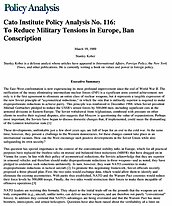These developments, unthinkable just a few short years ago, are full of hope for an end to the cold war. At the same time, however, they present a challenge to the Western democracies, for these changes cannot take place in an international vacuum. How can the West encourage such positive developments in the Soviet Union while also safeguarding its own security?
This question has special importance in the context of the conventional stability talks in Europe, which for all practical purposes have replaced the fruitless talks on mutual and balanced force reductions (MBFR) that have dragged on in Vienna for years. In line with their policy of asymmetrical reductions, the Soviets acknowledge that they are superior in armored vehicles and therefore should make disproportionate reductions in these weapons–and as noted, they have pledged to undertake such reductions unilaterally. In turn, however, they want NATO countries to make disproportionate reductions in tactical aircraft.[2] To promote this negotiating framework, Soviet officials recently proposed a three-phased plan. First, the two sides would exchange data, which would allow them to identify and eliminate the existing asymmetries. With parity thus established, NATO and the Warsaw Pact countries would reduce their force levels by 500,000 troops. Finally, the two sides would restructure their forces to make them incapable of offensive operations.[3]
NATO leaders are resisting this formula. They object to the initial trade-off on the grounds that the weapons are not truly comparable (e.g., aircraft, unlike tanks, can deliver nuclear weapons, and are therefore not purely “conventional” forces). In addition they contend that NATO’s advantages are being overstated and that the Warsaw Pact has more bombers, interceptors, and armed helicopters. Questions have also been raised about the verifiability of a limit on aircraft.[4]
Unfortunately, NATO members so far have been unable to decide what they should offer in response to the Soviet proposal. Their indecision, in turn, is leading to erosion of popular support for the alliance in Europe, and many Europeans are beginning to compare the United States unfavorably with the Soviet Union. In January 1988 the Wall Street Journal reported that “only 24 percent of the German public view the Soviet Union as a military threat today, the lowest level in the 25 years since the German Defense Ministry began tracking such sentiment.”[5] In the last years of the Reagan administration, it was commonplace for the Soviet Union and Mr. Gorbachev to outscore the United States and Mr. Reagan in European opinion polls.[6]
Such sentiment presents a serious challenge to leaders of the Western democracies. NATO is more than a military alliance designed to counter Soviet military power: it is an association of countries that share common democratic values. Those values are now being put to the test by Soviet overtures. Given the very real concessions offered by Moscow, the alliance members must respond with something, and ideally with something that has military significance and that captures popular imagination .
One proposal that could serve this purpose would be a ban on conscription. Such a proposal would be a dramatic departure from traditional arms control measures, but it has the simplicity of the zero-option, which was essential to demonstrating American sincerity in the INF negotiations. In addition a ban on conscription would markedly improve conventional stability, for can anyone imagine a major conventional war in Europe without the power to conscript?

